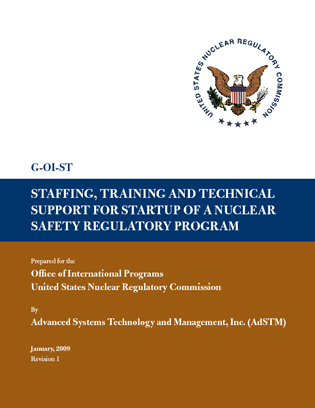G-OI-ST Staffing, Training, and Technical Support for Startup of a Nuclear Safety Regulatory Program

Table of Contents
- The role of the regulatory agency
- Staffing for the regulatory program
- Training for the regulatory staff
- The role of the TSO
- The role of organizations outside of the country
- Conclusions
- References
- Appendix A: Planning guidance for classroom instruction
Overview
When a nation embarks on a nuclear power program, a regulatory agency and its supporting organizations either needs to be created or changed to assure that the reactors are designed, constructed and operated in a safe manner. This paper addresses the challenge of meeting staffing and technical support requirements of the regulatory agency for the purpose of regulating nuclear power. It concludes that preparations must begin at the earliest possible date.
For a country that does not already have nuclear power, a reasonable estimate of the regulatory personnel needed to license the first reactor is about 40 staff. About 30 additional staff will be needed when the licensing of the second reactor begins. The agency should plan on taking several years to fully staff their new program. Depending on how early the agency starts recruiting, a hiring rate of five or more staff per year will be necessary to assure that staffing needs will be met. Given the need to provide training and practical regulatory experience to these staff, the regulatory agency should begin bringing new staff in at the earliest practical date. For a country that is planning to increase the scope of nuclear power generation, the above guidance would apply as appropriate.
This paper gives an overview of the skills required in the regulatory staff. The regulatory agency should be staffed with, and supervised and managed by, professionals who have broad knowledge and experience in the engineering disciplines and earth sciences. If at all possible, staff should also have basic knowledge of reactor physics, nuclear power technology, radiation protection, physical security, and emergency planning. This paper discusses the order in which staff should be hired, and provides one possible model for hiring. Consideration also needs to be given to information technology (IT) needs as well as administrative support staff.
Regulatory staff members should be trained to perform a variety of regulatory functions. This paper describes the functions which the regulatory staff must be prepared to perform. A sample training program is presented for illustrative purposes. The agency should enlist the aid of international organizations to provide training and rotational opportunities for staff.
The regulatory agency should rely on outside organizations for specialized knowledge not available from within. For example, the agency could rely on a technical support organization (TSO) within the country for technical skills that are needed on a recurring basis, and for the maintenance and use of specialized technical tools, such as computer analysis methods. The TSO could also be relied upon during periods of heavy workload to provide a broad spectrum of technical skills. These instances might include the review of a license application or the conduct of construction inspection. The regulatory agency should work to assure that adequate financial support exists to ensure continued availability of outside organizations relied upon for technical support.
For specialized technical skills that are needed on an infrequent basis that are not available from normal sources of technical support, the regulatory agency should rely on outside sources such as IAEA or contractors. In addition, the agency may periodically need the support of foreign countries and international organizations for response to emerging technical issues. The regulatory agency should begin to develop these relationships at a very early stage in the planning for a nuclear power program. When pursuing technical support from outside the regulatory agency, it is important to be sensitive to potential conflict-of-interest perceptions should these sources also be serving those being regulated.
